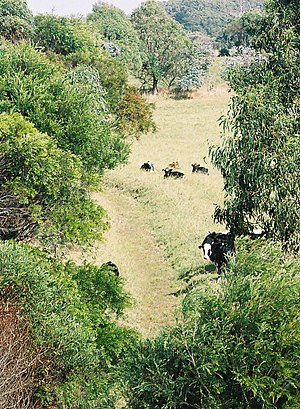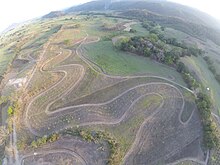| This article needs additional citations for verification. Please help improve this article by adding citations to reliable sources. Unsourced material may be challenged and removed. Find sources: "Keyline design" – news · newspapers · books · scholar · JSTOR (February 2008) (Learn how and when to remove this message) |

Keyline design is a landscaping technique of maximizing the beneficial use of the water resources of a tract of land. The "keyline" is a specific topographic feature related to the natural flow of water on the tract. Keyline design is a system of principles and techniques of developing rural and urban landscapes to optimize use of their water resources.
Australian farmer and engineer P. A. Yeomans invented and developed Keyline design in his books The Keyline Plan, The Challenge of Landscape, Water For Every Farm, and The City Forest.
Application
P. A. Yeomans published the first book on Keyline design in 1954. Yeomans described a system of amplified contour ripping to control rainfall runoff and enable fast flood irrigation of undulating land without the need for terracing it.
Keyline designs include irrigation dams equipped with through-the-wall lockpipe systems, gravity feed irrigation, stock water, and yard water. Graded earthen channels may be interlinked to broaden the catchment areas of high dams, conserve the height of water, and transfer rainfall runoff into the most efficient high dam sites. Roads follow both ridge lines and water channels to provide easier movement across the land.
Keyline Scale of Permanence
The foundation of Yeomans' Keyline design system is the Keyline Scale of Permanence (KSOP), which was the outcome of 15 years of adaptive experimentation on his properties Yobarnie and Nevallan. The Scale identifies the environmental elements of typical farms and orders them according to their degree of permanence as follows:
- Climate
- Landshape (topography)
- Water supply
- Roads and means of access
- Trees
- Structures (edifices)
- Subdivisional fences
- Soil
Keyline design considers these elements in planning the placement of water storage features, roads, trees, edifices, and fences. On undulating land, keyline design involves identifying ridges, valleys, and natural water courses and designing with them in mind in order to optimize water storage sites. Constructing interconnecting channels may be part of such optimization.
The identified natural water lines delineate the possible locations for the various less permanent elements, e. g. roads, fences, trees, and edifices, which if so located would help optimize the natural potential of the land in question.

Keypoint
In a smooth, grassy valley, a location denominated the keypoint is identified at which the lower and leveller portion of the primary valley floor suddenly steepens higher. The keyline of this primary valley is determined by pegging a contour line that conforms to the natural shape of the valley through the keypoint, such that all points on the keyline are at the same elevation as the keypoint. Contour plowing both above and below the keyline and parallel to it ipso facto is "off-contour", but the developing pattern tends to drift rainwater runoff away from the center of the valley and, incidentally, prevent erosion of its soil.
Cultivation conforming to Keyline design for ridges is done parallel to any suitable contour, but only on the high side of the contour's guide line. This ipso facto develops a pattern of off-contour cultivation in which all the rip marks made in the soil slope down towards the center of the ridge. This pattern of cultivation allows more time for water to infiltrate. Cultivation following Keyline pattern also enables controlled flood irrigation of undulating land, which increases the rate of development of deep, fertile soil.
In many nations, including Australia, it is important to optimize infiltration of rainfall, and Keyline cultivation accomplishes this while delaying the concentration of runoff that could damage the land. Yeomans' technique differs from traditional contour plowing in several important respects. Random contour plowing also becomes off contour but usually with the opposite effect on runoff, namely causing it to quickly run off ridges and concentrate in valleys. The limitations of the traditional system of soil conservation, with its "safe disposal" approach to farm water, was an important motivation to develop Keyline design.
Applications
David Holmgren, one of the founders of permaculture, used Yeoman's Keyline design extensively in the formulation of his principles of permaculture and the design of sustainable human settlements and organic farms.
Darren J. Doherty has extensive global experience in Keyline design, development, management, and education. He uses Keyline as the basis for his Regrarians framework, which he considers a revision and synthesis of Keyline design, permaculture, holistic management, and several other innovative, human ecological frameworks into a coherent process-based system of design and management of regenerative economies.
A topographical example of Keyline design is available at (37°09′33″S 144°15′08″E / 37.159154°S 144.252248°E / -37.159154; 144.252248).
Keyline design also includes principles of rapidly enhancing soil fertility. They are explored in Priority One by P. A. Yeomans' son, Allan. Yeomans and his sons were also instrumental in the design and production of special plows and other equipment for Keyline cultivation.
See also
References
Notations
- Yeomans, P.A. (1954). The Keyline Plan (Free online). OCLC 21106239.
- Yeomans, P.A. (1958). The Challenge of Landscape : the development and practice of keyline. Sydney NSW: Keyline. OCLC 10466838. Archived from the original (Free online) on 2015-05-03. Retrieved 2009-01-22.
- Yeomans, P.A. (1973). Water for Every Farm: A practical irrigation plan for every Australian property. Sydney NSW: K.G. Murray. ISBN 0-646-12954-6. ISBN 0-909325-29-4.
- Yeomans, P.A. (1971). The City Forest. Keyline. ISBN 0-9599578-0-4. OCLC 515050. Archived from the original (Free online) on 2015-05-19. Retrieved 2009-01-22.
- Yeomans, P.A.; Yeomans, K.B. (1993). Water for Every Farm — Yeomans Keyline Plan. Keyline Designs. ISBN 0646129546. 2002 ISBN 0646418750
- Yeomans, P.A.; Yeomans, K.B. (2008). Water for Every Farm — Yeomans Keyline Plan. Keyline Designs. ISBN 978-1438225784.
{{cite book}}: External link in|publisher= - Yeomans, A. (2005). Priority One: Together we Can Beat Global Warming. Keyline. ISBN 0-646-43805-0. Archived from the original (Online) on 2013-07-29.
- MacDonald-Holmes, J. "Geographical and Topographical Basis of Keyline". Archived from the original on August 15, 2010.
- Spencer, L (2006). "Keyline and Fertile Futures". Archived from the original on December 9, 2009.
Footnotes
- Keyline Designs website
- "Yobarnie Keyline Farm". NSW Environment, Energy & Science. Archived from the original on 3 March 2021. Retrieved 3 March 2021.
- Perkins, Richard. "Keyline Design". Ridgedale Farm AB. Archived from the original on 3 March 2021. Retrieved 3 March 2021.
- "Keyline Design - Mark IV". The Permaculture Research Institute. 16 March 2009. Archived from the original on 3 March 2021. Retrieved 3 March 2021.
- "Keyline Design". www.architectureanddesign.com.au. Archived from the original on 3 March 2021. Retrieved 3 March 2021.
- Fryers Forest on WikiMaps
- "6. The Subsoil Plow Story". yeomansplow.com.au. Retrieved 3 March 2021.
External links
| Permaculture | |
|---|---|
| Sciences | |
| Techniques | |
| Components | |
| Organizations | |
| Permaculturalists | |